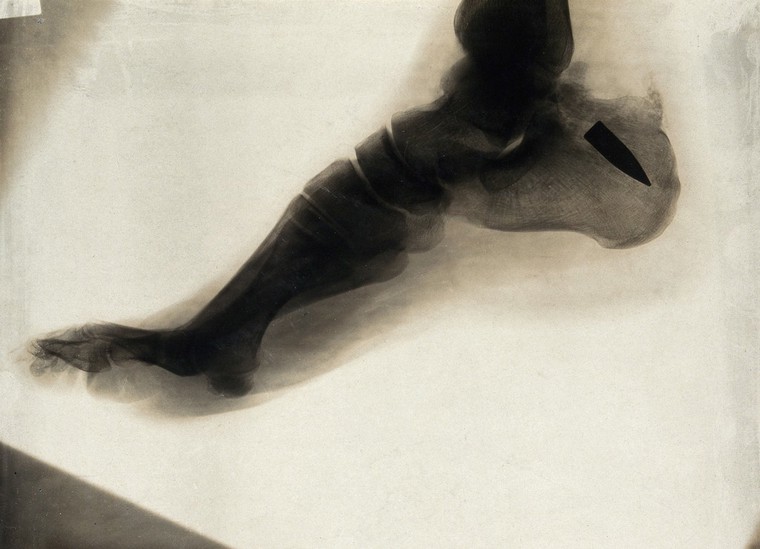X-Rays: Earlier than I Realized

A machine gun bullet embedded in a foot bone: x-ray. Photograph, 1914/1918. Wellcome Collection. In copyright
Every book I write leads me down unexpected byways that inform what I write, and even what I think, but don’t actually appear on the page. In the case of Sigrid Schultz, I regularly found myself up against questions of technology. Often I pursued a technical question because I wanted to understand how Schultz and her colleagues transmitted their stories overseas.* (I will admit, I still do not entirely understand how reporters were able to send photographs, maps and other illustrations by radio.) Other times, I was presented with the technical aspects of a story Schultz was covering—these were the days when innovation in general and aviation in particular were hot stuff.
And occasionally I wanted to understand when a particular technology came into existence and how prevalent it was in the period I am working on. In some cases—the microphone for instance—putting a technology into the timeline actually made the story clearer in my head. In other cases, though, I just hit something that spurred my curiosity and sent me down a happy rabbit hole.
For example, Sigrid Schultz casually mentioned having her knee x-rayed after an accident in 1941. I was surprised. Somehow I had assumed, based on no information whatsoever, that x-rays were a later technology. Wrong.
German physicist Wilhelm Roentgen accidentally discovered x-rays in 1895 while testing whether cathode rays could pass through glass.** Roentgen must have also been inclined to travel unexpected byways: after some experimentation he learned that when he projected what he called X (as in unknown) rays toward a chemically coated screen, they could pass through most substances, including human tissue, but would leave shadows of higher density objects, like bones, on the screen. Moreover, the resulting images could be photographed.
News of his discovery, and its potential medical uses, spread quickly. Within a year, doctors through Europe and the United States were using the new technology to view broken bones, kidney stones, bullets, and even swallowed objects without having to cut the patient open. A few researchers, including Thomas Edison and Nikola Tesla, warned of possible dangers from radiation exposure, but they were largely ignored. By the 1930s and 1940s, x-ray technology was so common that some shoe stores offered customers free e-rays of their feet.***
Roentgen won the first Nobel prize in physics for his discovery in 1901.
* They had choices: the mail, telephone, wireless, and cable—and combinations thereof. Which one they chose depended on a complicated trade-off between time and money that varied from story to story. None of the methods were entirely reliable and bureau chiefs like Schultz spent a great deal of time trying to organize ways for correspondents and “stringers” located outside London, Paris and Berlin to get their stories to the home office.
**This is the point at which I realized I didn’t know what cathode rays were and wandered down an adjacent rabbit hole. For those of you who are similarly inclined, this is the most understandable of the sources I found: https://www.thoughtco.com/cathode-ray-2698965
***Why customers would want to see the bones in their feet is not clear to me.




